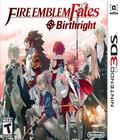Buy Fire Emblem Fates: Birthright
Fire Emblem Fates is actually two games released at the same time: Fire Emblem Fates: Birthright and Fire Emblem Fate: Conquest. It's pretty understandable that they'd be confused for something akin to Pokemon X and Y, but they're actually two different games that share the same first six levels and the same basic characters. Birthright and Conquest put you on different sides of the war and have different levels and gameplay mechanics. Birthright is more akin to Fire Emblem: Awakening, with the ability to grind levels and maps focused around routing the enemy, while Conquest is a more linear experience like the old Fire Emblem titles. At first blush, Birthright might come across as the easy version of the two, but it's a well-designed franchise entry on its own.
Fire Emblem Fates follows the story of two warring nations, Hoshido and Nohr. Corrin, a Prince (or Princess) of Nohr, has lived a life of isolation. After refusing the emperor's order to execute prisoners, Corrin is sent on a mission that leads to capture by Hoshido. Corrin learns that he's a member of the Hoshido royal family who was kidnapped by Nohr's emperor and kept as a hostage during a political dispute. Corrin is torn between loyalty to the family he grew up with or the family he was born into. In Birthright, he chooses to return to the family of his birth and defeat the evil of the Nohr emperor.
Birthright starts off weak but gets better as it progresses. The first six chapters are overly rushed and desperate to introduce everything you'll need to set up Birthright and Conquest. Your protagonist is kidnapped, part of an assassination attempt, transforms into a dragon, and finds a magic sword in such quick succession that it's kind of bewildering. Once you get past the sixth chapter, the game slows down and characters and plot elements are introduced at a more subdued and natural pace. The story is a standard Fire Emblem plot with some twists, and it's buoyed by fun characters and charming writing.
On the surface, the core Fire Emblem gameplay hasn't changed too much from previous entries. It's a turn-based, grid-based SRPG where players and enemies take turns moving their units and attacking one another. Combat automatically plays out once players select Attack and their weapon of choice, though various stats and other elements can influence the combat. By default, death in the game is permanent. Losing any character causes them to be permanently removed from your party, and the game is balanced around this. There are options to turn this off, though. If you played Fire Emblem: Awakening, Birthright will feel familiar, but there are also a lot of new changes.
One of the first major changes to the formula for Fates is the removal of weapon durability. In previous games, weapons had limited usages with rare exceptions and would be permanently unusable once they ran out. In Fates, each weapon, with the exception of magic healing rods, can be used infinitely but has specific strengths and weaknesses. Bronze weapons can be wielded by anyone but can't use special abilities or be critically hit. Iron weapons are reliable but not exceptional. Silver weapons hit hard once and then are weak until your next attack. This gets more meaningful with special weapons. An Armorslayer is great against armored foes but extremely weak otherwise. You'll get weapons that can invert the weapon triangle, weapons that do more damage upon counterattack but reduce your dodge, and so on.
It's a fantastic system that increases the complexity and depth of the gameplay since you must consider how your weapon advantages and techniques play out. Is it worth using a Dual Naginata to invert the weapon triangle, knowing it might leave you vulnerable to a sword in the next round? Is it better to use the bow that gives you a dodging buff rather than one that does more damage? There are some minor flaws with the system. Several characters, including Corrin, can access custom weapons that outstrip everything else. It's disappointing because the advantages of their customized weapons are so significant that there is no reason to choose other weapons. Another problem is that several weapons are absurdly good and have no significant weaknesses. For example, the Guard Naginata provides a massive defense buff and should be balanced by its relatively low attack, but it's still strong enough that the early game becomes ridiculously easy.
Another significant change to the game is status debuffs. While they've existed in previous Fire Emblem titles, they've never had as large an impact as they did here. Characters now have multiple ways to weaken enemy stats. Ninjas using shurikens apply powerful debuffs, and many characters have special abilities that weaken foes simply by engaging in battle. The Speed stat determines if a character gets to attack twice in a combat round instead of once. Debuff a speed stat, and a powerful enemy who would get in two attacks only gets one, or perhaps your character gets two attacks instead. Of course, enemies can take advantage of this too.
The Dual Attack/Dual Defense system from Awakening returns with huge improvements. You effectively have two options: Dual Attack and Pair Up. With Dual Attack, if a character stands next to the character that is attacking, he or she adds an attack of their own to the mix. Pairing Up characters causes them to grant a small stat boost to the other character. They also build up a defense gauge as the paired unit fights. When the gauge is full, the supporting character automatically defends against the next attack. A big change from Awakening is that enemies can use these systems, too. However, a paired unit is immune to being attacked by a supporting enemy. This goes both ways, so your party can't dual-attack a paired-up enemy unit.
It's a much more interesting system because it constantly asks you to consider the best option. Early in the game, Dual Attacking is dominant, and later on, Dual Defending becomes more useful, but neither is entirely eclipsed. It's a huge improvement over the last game and shores up one of Awakening's weakest points.
What makes Birthright shine is the amazing map design. Awakening had flat, static maps, but Birthright has well-designed maps that constantly challenge your tactical skills. Some maps have tight chokepoints that require careful planning to avoid getting swarmed while others constantly shift back and forth. Yet another is set in a multi-floor tower with different paths. One early map involves trekking through a ninja forest where you have to deal with damaging traps in addition to attacking ninjas. Every map has something distinctive and asks you to consider your movements and tactics. A wrong move can be a disaster, but careful planning can make an impossible situation feel easy. Not every map is a hit, but there are more hits than misses.
Part of what makes this fun is the Dragon Vein system. Any character who qualifies as a noble (marked by a crown on his/her character portrait) can use a Dragon Vein, which lets them alter the landscape. This may involve freezing a lake to make it passable, creating bridges where none existed before, and setting traps. Not every Dragon Vein is positive. Creating a healing field is good if you control the area but can also benefit your enemies. It's a cool system that rewards players who consider their movements carefully instead of just being a Win Button.
There are a lot of small tweaks to combat. Birthright allows you to grind for experience, but it is not as easy to revert to lower levels as it was in Awakening, so you're unlikely to constantly boost your stats. Instead, you can now access seals that let you change classes without losing levels, so you can learn skills and abilities without having to grind from scratch. This requires you to think carefully about which skills you'll learn rather than being able to eventually get everything. Partner seals, for example, can only be used on someone the character has S-ranked with, so you have to think about how to get powerful abilities on your characters. There are ways around this (including buying skills from other players), but that can deplete your money reserves quite a bit.
This increased complexity comes with an increase in difficulty, too. I played the game on Hard mode, but even Normal mode would've been a step up from Awakening. Enemies are strong, there are more factors to consider, and the more nuanced weapons mean you can't expect a single character to fight entire armies without thought. The game feels extremely fair, and each victory feels like you've earned it. Those worried about the difficulty level can pick two alternate play modes (one is only available on Normal difficulty). Casual mode, returning from Awakening, turns off the game's permadeath option. Phoenix mode revives characters on the next turn, which is great for those who only want to experience the story.
Birthright is packed with content. It's about as long as Awakening and has a number of bonus missions and optional content to explore. Between missions, you can visit your customizable castle. You can build various buildings that allow you to play a daily lottery, forge weapons, battle in a combat arena or even cook meals for your army. You can also visit other players' castles to explore and take them on in combat. You can also invite members of your party to your room for conversations, which is a half-baked feature. It was adjusted from the Japanese version to tone down a weird face-petting minigame. Between missions, you have many options on how to spend your time, including Paralogue missions that unlock new characters.
One element that feels rather lackluster is the child mechanic. As in Awakening, getting two characters to S rank causes them to marry and have a kid. Rather than being visitors from the future, they're children raised in special time-distorted alternate dimensions. That's always weird, especially when you try to figure out the timeline, but the children don't feel like a well-integrated part of the plot. Some are literally characters from Awakening but reincarnated as someone else's children. Rather than being a sensible mechanic, it feels like it was included because Awakening had it, even though it doesn't make any sense for the story.
Visually, not a lot has changed from Awakening. The character models have been cleaned up a bit, including replacing odd hooves with actual feet, but they're still about the same in quality. There are a handful of nice-looking cut scenes, but like the other games in the series, it's mostly a talking-heads affair. The soundtrack is fantastic, and it's great how the music shifts from the quiet environment to heated combat when you start an attack animation. The only downside is the annoying voice acting. Rather than being fully acted, characters have brief snippets of dialogue that play over every line and are frequently repetitive or annoying. This isn't a new problem for Fates, but it's a minor blemish on an otherwise fantastic soundtrack.
Fire Emblem Fates: Birthright is a fantastic addition to the series and easily one of the best Fire Emblem games. The new mechanics and combat changes are almost all for the better, and they go hand in hand with the awesome level design and engaging gameplay. The only real flaws are some lackluster story beats and a rather half-baked system for bringing back child characters, neither of which comes remotely close to souring the game. Fans of the franchise will find a lot to love here, and newcomers should find Birthright to be an excellent place to be introduced to the franchise's strong points.
Score: 9.0/10
More articles about Fire Emblem Fates










 Players must choose to take one of two major paths, resulting in two different experiences: the Hoshido side for a more traditional experience, or the Nohr side, which makes the story more complex and the difficulty level more challenging.
Players must choose to take one of two major paths, resulting in two different experiences: the Hoshido side for a more traditional experience, or the Nohr side, which makes the story more complex and the difficulty level more challenging.



































